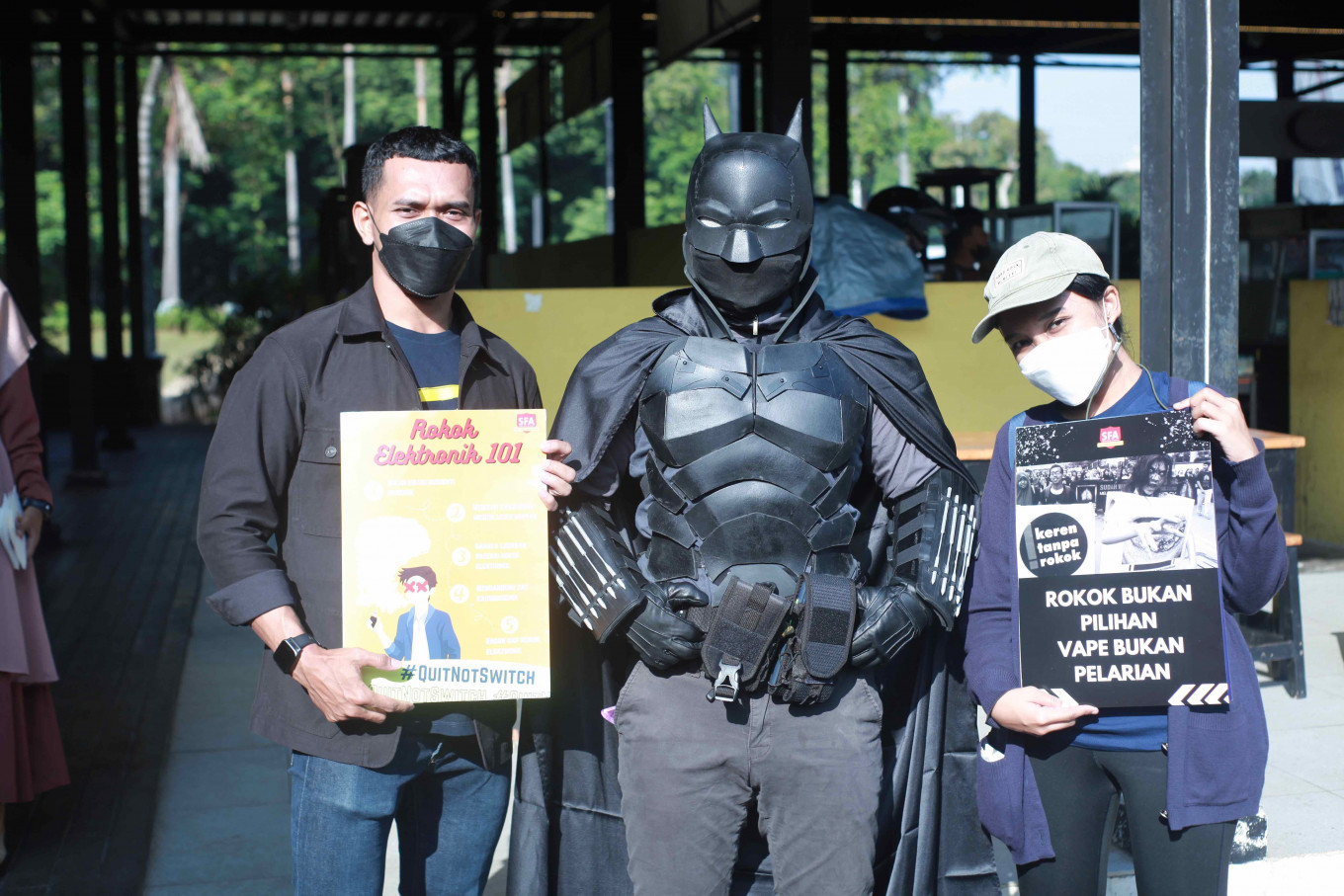Popular Reads
Top Results
Can't find what you're looking for?
View all search resultsPopular Reads
Top Results
Can't find what you're looking for?
View all search resultsThe long fight against tobacco epidemic
Increased taxes on tobacco products to reduce their affordability remains the most cost-effective tool to reduce consumption.
Change text size
Gift Premium Articles
to Anyone
 Members of Social Force in Action (SFA) for Tobacco Control hold an education and advocacy campaign at Gelora Bung Karno Sports Complex on March 27, 2022. (Courtesy Social Force in Action for Tobacco Control) (Courtesy of Social Force in Action for Tobacco Control)/Courtesy of Social Force in Action for Tobacco Control))
Members of Social Force in Action (SFA) for Tobacco Control hold an education and advocacy campaign at Gelora Bung Karno Sports Complex on March 27, 2022. (Courtesy Social Force in Action for Tobacco Control) (Courtesy of Social Force in Action for Tobacco Control)/Courtesy of Social Force in Action for Tobacco Control))
I
n the past 20 years, tobacco use has dropped by one-third globally, and there are an estimated 118 million fewer tobacco users today compared with 2005.
Why? In large part because 20 years ago this week, after years of negotiation, the World Health Organization Framework Convention on Tobacco Control (WHO FCTC) entered into force, one of the most widely embraced United Nations treaties in history.
The WHO FCTC was, and remains, a landmark in international law: The first treaty negotiated under the WHO Constitution, incorporating multiple measures to control the demand and supply of tobacco.
Today the convention has 183 parties, covering 90 percent of the world's population. More than 5.6 billion people are protected by the comprehensive implementation of at least one tobacco control measure.
For example, 138 countries now require large pictorial health warnings on cigarette packages, and dozens of countries have implemented plain packaging rules that prohibit branding on cigarette packages, making them less attractive.
In addition, 66 countries have implemented bans on tobacco advertising, promotion and sponsorship.
More than one-quarter of the world’s population is protected by bans on indoor smoking and other smoke-free laws;
Increased taxes on tobacco products to reduce their affordability remains the most cost-effective tool to reduce consumption. Tobacco taxes can also raise government revenues for tobacco control and health financing.
Furthermore, in 2018 an additional legal instrument entered into force: A protocol to eliminate all forms of illicit trade in tobacco products, which undermines control measures, diminishes tax revenues and fuels criminal activities.
Despite this progress, tobacco remains the world’s leading cause of preventable death and a major driver of heart disease, stroke, cancer, chronic respiratory diseases and diabetes.
There remain around 1.3 billion tobacco users globally, fueled by a multi-billion dollar industry that peddles addictive and deadly products and profits from the suffering of those who use them.
Faced with dwindling sales of cigarettes, the industry is turning to new products such as e-cigarettes, which are falsely advertised as healthier alternatives even though they generate toxic substances, some of which are known to cause cancer and some that increase the risk of heart and lung disorders.
Tobacco manufacturers spare no effort in hooking millions of young people onto their products. Only 56 countries will reach the global goal of a 30 percent reduction in tobacco use by 2025.
Tobacco is not only a health problem. It threatens sustainable development as a whole. The economic cost of smoking, from health expenditures and productivity losses, is estimated at 1.8 percent of the world's annual gross domestic product.
Our planet also counts among tobacco’s victims. Roughly 4.5 trillion cigarette butts are discarded every year into our environment, the second-highest form of plastic pollution in our world.
Valuable agricultural land and water are wasted on growing tobacco instead of food. Production and consumption of tobacco also contribute to global warming, releasing 80 million tonnes of carbon dioxide into the air every year.
For all these reasons, the WHO FCTC remains as relevant today as it did when it entered into force 20 years ago, although its implementation remains uneven across countries and many areas require strengthening.
All countries can do more, including by banning tobacco sponsorship and advertising in traditional media and social media, and by protecting public health policies from tobacco industry interference.
By fully implementing its provisions, countries can protect the health of their people, their economies, and their environment for decades to come.
***
Tedros Adhanom Ghebreyesus is World Health Organization director general. Adriana Blanco Marquizo is head of the Secretariat of the WHO Framework Convention on Tobacco Control.










